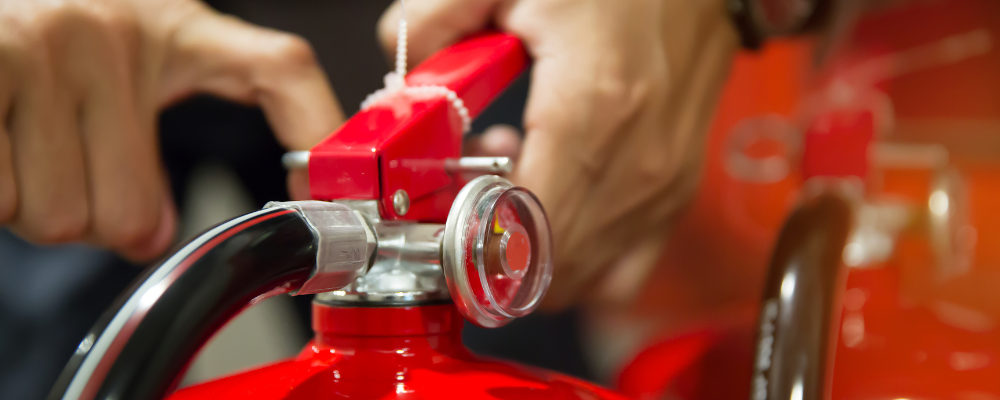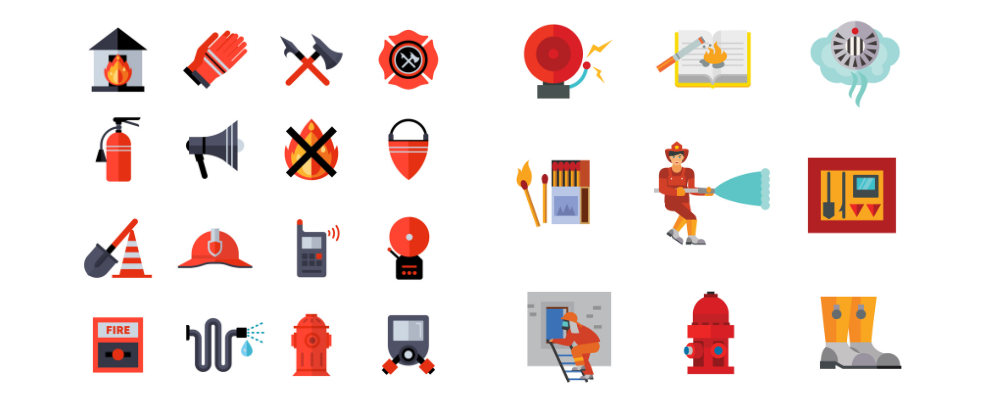
Introduction:
In the high-risk and dynamic environment inherent to construction sites, prioritizing safety remains an indispensable mandate. Within this landscape fraught with potential hazards, fire outbreaks pose a significant threat, causing substantial damage and endangering lives. As guardians of safety within this domain, Site and Safety Solutions acknowledge the pivotal role that fire extinguishers play in averting catastrophic consequences.
Our commitment to safeguarding construction sites is underscored by meticulously curating cutting-edge fire extinguishing products. Among our distinguished arsenal, the Badger™ Extra High-Flow 10 lb ABC Fire Extinguisher with its Wall Hook embodies our dedication to precision and effectiveness. Designed to combat Class A, B, and C fires, this extinguisher is a versatile solution, adept at swiftly neutralizing fires arising from combustible materials, flammable liquids, and electrical sources.
In complementing this flagship product, our range encompasses the FireTech™ Canned Smoke, a specialized tool crafted to verify and ensure the functionality of fire detection systems. This product is a testament to our commitment to holistic safety, addressing firefighting and the critical aspect of early fire detection.
Moreover, acknowledging the unique risks posed by vehicular incidents within construction sites, the Kidde 2.75 lb BC Automotive Extinguisher FC10 caters to these scenarios. Compact yet potent, this extinguisher is a dedicated defense against vehicle-related fire hazards, providing additional protection for construction machinery and vehicles.
What are Fire Extinguishers
Fire extinguishers are indispensable tools designed to suppress or extinguish small fires, preventing them from escalating into larger, more destructive blazes. These devices are crucial components of fire safety equipment, available in various types and classifications to combat specific types of fires.
Classification and Types
Fire extinguishers are categorized based on the types of fires they can effectively combat:
- Class A Fire Extinguishers: Designed for fires involving combustible materials like wood, paper, cloth, and certain plastics.
- Class B Fire Extinguishers: Suitable for fires fueled by flammable liquids such as gasoline, oil, grease, and solvents.
- Class C Fire Extinguishers: Intended for electrical fires involving live electrical equipment.
- Class D Fire Extinguishers: Specifically crafted for fires resulting from combustible metals like magnesium, sodium, potassium, and titanium.
- Class K Fire Extinguishers: Tailored for kitchen fires that involve cooking oils, fats, and greases.
Components and Working Mechanism
A typical fire extinguisher comprises several key components:
- Cylinder: The container holding the extinguishing agent.
- Pressure Gauge: Indicates the pressure level of the extinguisher.
- Nozzle or Hose: Allows for the directed discharge of the extinguishing agent.
- Handle and Activation Mechanism: Enables users to activate and control the discharge.
The working mechanism involves the release of an extinguishing agent stored under pressure. Upon activation, the agent is expelled through the nozzle or hose, suffocating the fire by either cooling the burning material, suppressing the chemical reaction, or cutting off the fire’s oxygen supply.
Importance and Usage
Fire extinguishers are pivotal in mitigating fire risks in various settings, including residential, commercial, industrial, and construction sites. Proper usage involves following the PASS technique:
- Pull the pin to unlock the extinguisher.
- Aim the nozzle or hose at the base of the fire.
- Squeeze the handle to discharge the extinguishing agent.
- Sweep the nozzle or hose from side to side across the base of the fire until extinguished.
Maintenance and Inspection
Regular maintenance and inspection are critical to ensure the functionality of fire extinguishers. Scheduled checks involve examining the pressure gauge, confirming the seal’s integrity, and ensuring the extinguishing agent remains viable. Professional servicing may be necessary periodically to recharge or replace the extinguishing agent.
These fire-extinguishing solutions’ careful selection and curation align with our unwavering commitment to mitigating diverse fire risks encountered within construction zones. Each product within our repertoire embodies a fusion of innovation, reliability, and adherence to stringent safety standards, ensuring that construction workers are equipped with tools that transcend expectations and address the multifaceted challenges of fire emergencies.
At Site and Safety Solutions, our ethos revolves around not just providing products but crafting solutions that fortify the safety framework of construction sites. Our array of meticulously designed fire-extinguishing tools shield against the unpredictable nature of fires, underscoring our dedication to safeguarding lives, infrastructure, and the environment within the construction domain.
Importance of Proper Fire Extinguisher Use: Training and Awareness
Training Sessions:
In construction sites’ dynamic and often hazardous environments, ensuring comprehensive training in fire safety protocols for construction workers is paramount. Training sessions must emphasize using fire extinguishers to combat potential fire hazards.
Utilizing the PASS Technique:
The cornerstone of effective fire extinguisher usage lies in understanding and implementing the PASS technique:
- Pull the Pin: Commence by pulling the pin, an initial step that activates the extinguisher.
- Aim at the Base of the Fire: Direct the extinguisher nozzle at the base of the fire, targeting the source rather than the flames themselves.
- Squeeze the Trigger: Squeeze the trigger gradually to release the extinguishing agent, maintaining control over the dispersion.
- Sweep from Side to Side: Employ a sweeping motion from side to side, covering the base of the fire comprehensively until extinguished.
Reinforcing Safety Protocols:
Regular and repeated training sessions reinforce the importance of adhering to safety protocols, ensuring that construction workers are well-prepared to handle fire emergencies efficiently.
Strategic Placement of Fire Extinguishers
Regulatory Adherence:
Strategic placement of fire extinguishers across construction sites must align with regulatory standards. These standards dictate the quantity and location of fire extinguishers to ensure optimal accessibility during emergencies.
The Significance of Placement:
Placing fire extinguishers in high-risk areas, such as the Badger™ Extra High-Flow 10 lb ABC Fire Extinguisher equipped with a wall hook, is instrumental. These high-risk zones, including areas with electrical equipment, flammable materials, or confined spaces, demand immediate access to extinguishing tools in case of fire outbreaks.
Swift Accessibility:
Strategic placement ensures swift accessibility, enabling construction workers to respond promptly to fire incidents. With its wall hook, the Badger™ Extra High-Flow 10 lb ABC Fire Extinguisher offers easy access and is a proactive measure to mitigate potential fire damage.

Regulatory Compliance and Maintenance
Compliance Standards
Ensuring adherence to regulatory standards is our commitment at Site and Safety Solutions. Our suite of fire extinguisher products, including the Badger™ Extra High-Flow 10 lb ABC Fire Extinguisher w/ Wall Hook, FireTech™ Canned Smoke, and Kidde 2.75 lb BC Automotive Extinguisher FC10, undergoes rigorous scrutiny to meet and exceed industry-specific compliance requisites.
Stringent Standards Implementation: Our products are engineered and manufactured per established regulatory benchmarks, guaranteeing reliability and effectiveness. Specifically tailored for construction settings, these extinguishers address a spectrum of fire classes prevalent in such environments, encompassing combustible materials, flammable liquids, electrical fires, and more.
Certifications and Testing: Each fire extinguisher undergoes meticulous testing and certification processes before deployment. These evaluations ensure their capacity to combat diverse fire hazards encountered on construction sites, assuring optimal performance when it matters most.
Regular Maintenance
Adhering to a stringent maintenance regimen is non-negotiable to uphold the functionality and reliability of our fire extinguishers. Routine inspections and systematic maintenance schedules are imperative to our commitment to safety and efficacy.
Inspection Protocols: Trained professionals conduct regular inspections, examining critical components such as pressure levels, seals, and the integrity of extinguishing agents. These inspections adhere to a comprehensive checklist, leaving no room for oversight in ensuring the readiness of our products.
Preventative Measures: Beyond reactive maintenance, our protocols emphasize preventive measures. Early detection of potential issues and proactive intervention through maintenance not only safeguards the functionality of fire extinguishers but also ensures their immediate readiness in emergencies.
Compliance Documentation: Detailed records of maintenance activities and compliance with regulatory guidelines are maintained meticulously. This documentation is a testament to our dedication to quality, enabling transparent accountability and traceability for each fire extinguisher.
By upholding the highest standards of compliance and maintenance, Site and Safety Solutions reaffirms its commitment to safeguarding construction sites against fire hazards. Our dedication to stringent regulations and meticulous maintenance protocols ensures that our fire extinguisher solutions stand as beacons of reliability and effectiveness in the face of potential risks.
For more information, visit our website and Facebook page.
For more products, visit our website :
Badger™ Extra High-Flow 10 lb ABC Fire Extinguisher w/ Wall Hook
Kidde 2.75 lb BC Automotive Extinguisher FC10
Conclusion
The construction landscape is fraught with risks, among which fire hazards loom as a significant threat. Recognizing this peril, it is imperative to empower construction workers with the tools and knowledge to combat these potential disasters effectively.
At Site and Safety Solutions, our commitment to safety is unwavering. We believe that providing high-quality fire extinguisher solutions is not just a service but a responsibility. Our range of fire extinguishers, including the Badger™ Extra High-Flow 10 lb ABC Fire Extinguisher w/ Wall Hook, FireTech™ Canned Smoke, and Kidde 2.75 lb BC Automotive Extinguisher FC10, is meticulously designed to cater specifically to the diverse fire risks inherent in construction environments.
However, providing equipment alone is not sufficient. The combination of these advanced tools with comprehensive safety protocols and proper training fortifies construction sites against the devastating impact of fires. Our commitment extends beyond product provision; it encompasses education, training, and support, ensuring that construction workers are well-equipped to face fire emergencies effectively.
Adherence to safety protocols remains the cornerstone of our approach. We emphasize the importance of training sessions, imparting the knowledge of proper fire extinguisher usage through techniques like the PASS method. This ensures that workers can act swiftly and decisively when faced with a fire emergency, minimizing potential damages.
Moreover, the strategic placement of fire extinguishers in compliance with regulatory standards further enhances the preparedness of construction sites. Placing our Badger™ Extra High-Flow 10 lb ABC Fire Extinguisher within easy reach, equipped with a wall hook, is a testament to our dedication to accessibility and readiness.
As we conclude, we urge all stakeholders in the construction industry to prioritize proactive prevention through adopting efficient fire safety measures. Today’s diligence ensures a safer tomorrow on the construction site. It’s not just about mitigating risks; it’s about fostering a culture of safety and preparedness where every worker understands their critical role in ensuring a secure work environment.










